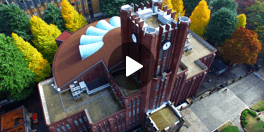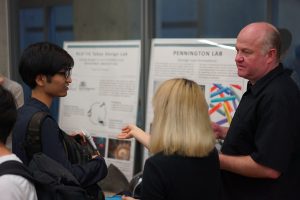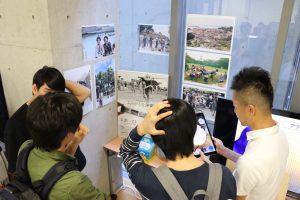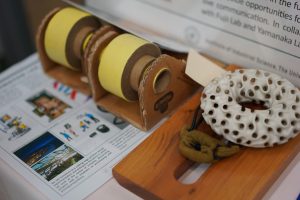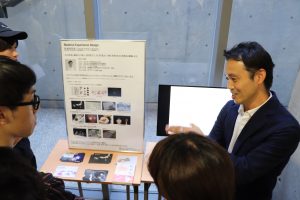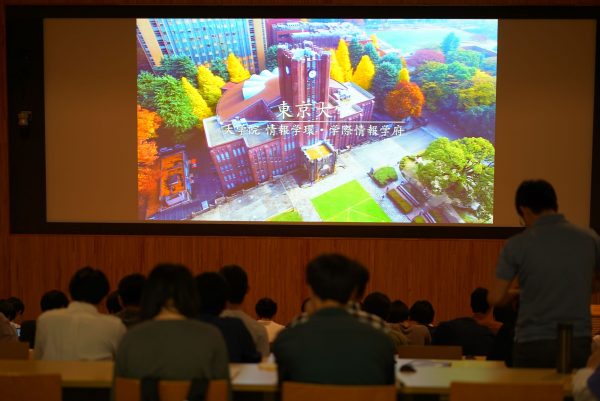
July 19, 2018
平成31年度 学府 入試説明会 開催報告A report on orientation for the 2019 GSII entrance examination
2018年6月2日(土)、平成31年度学際情報学府入試説明会が本郷キャンパスの福武ホールで開催されました。330名を超える受験生が集まり、活気に満ちた説明会となりました。
学際情報学府と各コースの紹介
説明会の前半では、学府長と専攻長からの挨拶と、コース長の先生方からのコース紹介がありました。学府長や専攻長からは、特に超融合をキーワードとした新たな学際についてのお話がありました。各コース長の先生方からも、学際、情報、文化についての興味深いお話がありました。今年度より生物統計情報学コースが加わり、より多様化した教員と学生の連携による新たな学際的な研究が始まります。
各研究室のブース展示
説明会の後半にあるブース展示は、全コースの研究が一堂に会する入試説明会のメインイベントです。今年度より新たに情報学環に着任された教員の方々をご紹介します。
まずはPennington Miles先生です。Pennington先生は、イギリスのロンドンにある王立芸術大学院大学、Royal College of Art(RCA)で教鞭を執られ、デザインイノベーションに関する数多くのプロジェクトを推進してきました。2016年12月からは東京大学生産技術研究所(生研)と協同でデザインプロジェクトを推進する組織RCA-IIS Tokyo Design Labを設立し、生研の技術とデザインを掛け合わせた作品やプロダクトを制作しています。今年度からは学際情報学府の学生を受け入れ、学府の多岐に渡る先端研究とデザインイノベーションを融合させた新たな学術研究に取り組まれるとのことです。
次に筧康明先生です。筧先生は、慶應義塾大学環境情報学部で教鞭を執られ、モノの素材特性とデジタルテクノロジーを掛け合わせたインタラクティブメディアに関する数多くの研究を手がかけてきました。今回のブース展示では、Material Experience Design というテーマで、実世界の素材の変化を活用したメディア表現を数多く紹介していました。今年度は、「Activating the Physical」というキーワードのもと、モノや身体が存在する物理世界とコンピュータにより構成されるデジタル世界との間に新たな架け橋を作ること、両者の特性を融合した新たな「リアル」ワールドを開拓することに取り組まれるとのことです。
最後に渡邉英徳先生です。渡邉先生は、首都大学東京システムデザイン学部で教鞭を執られ、「記憶の解凍」をテーマに、デジタルアーカイブと情報デザインの研究を推進してきました。渡邉先生の代表的な研究の一つが、ヒロシマ・アーカイブというデジタルアーカイブの研究です。これは、インターネットや資料館などに散在していた資料をGoogle earth空間上に紐付けることで、資料同士の時間的・空間的な繋がりを分かりやすく見せる取り組みです。このアーカイブには現地の方々が対話を通じて生み出した深い事実も掲載されているそうです。データが潜在的に有する価値や記憶を掘り起こして、いかに人に伝えるか、社会に還元するかということに取り組まれています。
以上、学環・学府の新たな学際の可能性を改めて感じた今年度の入試説明会報告でした。
記事:福嶋政期(助教)
写真:濱田健夫(助教)、福嶋政期(助教)
英文校正:デイビッド・ビュースト(特任専門員)
On June 2nd, 2018, orientation for the 2019 entrance exam of the GSII (Graduate School of Interdisciplinary Information Studies) was held at Fukutake hall on Hongo campus. The atmosphere at the meeting was energetic, and more than 330 students participated.
Introduction of GSII and its courses
The dean and head of department gave opening speeches about Gakkan’s mission, structure, and the history of the courses. They especially emphasized the aim for “transdisciplinarity” where new academic fields are created that transcend existing disciplinary divisions. The Directors of each course also talked about interdisciplinarity, information and culture. From this year, the new Biostatistics and Bioinformatics Course has begun accepting students. As the diversity of students and faculty increases, the potential for interdisciplinary research is further enhanced.
Exhibition of laboratories
An exhibition was held introducing the work of individual laboratories and faculty members in both the arts and sciences. This article highlights the work of several researchers who joined GSII this year.
The first is Professor Pennington Miles, who has taught at the Royal College of Art (RCA) in London, England, and has promoted numerous projects on design innovation. From December 2016, he established an organization called RCA-IIS Tokyo Design Lab to encourage design projects in cooperation with researchers at the Institute of Industrial Science (IIS) in the University of Tokyo and produced various works and products by combining IIS core technologies and his design skills. From this year, he will start to welcome GSII students and will open up a new academic field by combining the diverse academic research of the GSII with his design innovation skills.
Next is Assistant Professor Yasuaki Kakehi. He has been teaching at the Faculty of Environmental and Information Studies in Keio University and has been engaged in varied research on interactive media that integrates material properties of physical objects and digital technology. In the exhibition, he introduced numerous media expressions utilizing transformations of physical material titled “Material Experience Design.” This year, under the keyword “Activating the Physical,” he will tackle the creation of a new bridge between bits and atoms in real space and a new “real” world integrating the characteristics of both.
Last but not least is Professor Hidenori Watanabe. He taught at the Faculty of System Design in Tokyo Metropolitan University and has promoted research on digital archives and information design with the theme of “Rebooting Memories.” One of his representative works is research on a digital archive called the Hiroshima Archive. This is an effort to make it easy to understand the temporal and spatial connections among material about the Hiroshima Bombings scattered on the Internet or in museums by anchoring them on the space of Google Earth. This archive also includes deep factual information generated from dialogue among local people. Professor Watanabe is seeking ways to unearth potential value and memory from data, and to convey them to people and society.
Text: Shogo Fukushima (Assistant professor)
Photo: Takeo Hamada (Assistant professor), Shogo Fukushima (Assistant professor)
Proofreading: David Buist (Project senior specialist)
